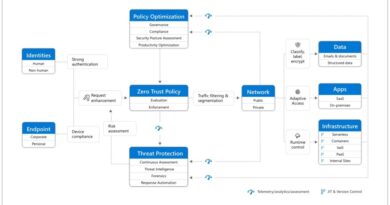5 reasons to adopt a Zero Trust security strategy for your business

Adopting Zero Trust security for your enterprise is no longer a wish-list item—it’s a business imperative. The workplace today extends to almost anywhere, anytime, from any device. Siloed, patchwork security solutions leave gaps that threat actors continue to exploit. A comprehensive Zero Trust model provides the integrated security today’s organizations require, reaching across the digital estate to continuously verify every transaction, assert least-privilege access, and provide real-time responses to threats.
Whether you’ve already begun your journey to adopt Zero Trust architecture or are just wanting to learn more, the Microsoft Zero Trust Maturity Assessment Quiz can help shed light on possible vulnerabilities within your organization. In this blog, we’ll focus on how your business can benefit by presenting five practical scenarios in which enabling Zero Trust can help you do more with less so you can move forward fearlessly.
1. Enabling a more productive workplace through remote or hybrid work
According to the Zero Trust Adoption Report, 81 percent of enterprise organizations surveyed had already started moving toward a hybrid workplace. This massive shift has forced organizations to adapt rapidly, often in ad-hoc fashion. Employees are getting work done at home, in an airport or hotel room, or at the gym—all while collaborating through cloud services, sharing data on corporate and home networks, and switching between business and personal devices.
Protecting your organization means that the three principles of Zero Trust need to be enforced while monitoring networks, data, and apps across all connected devices. Every device with access to corporate resources—company-owned or personal—should be managed by your IT. Your security operations (SecOps) team can protect remote users’ devices against credential compromise with tools like multifactor authentication1 and risk assessment using Identity Protection in Microsoft Azure Active Directory,2 as well as Microsoft Intune app-protection policies.3
A Zero Trust approach not only protects against security gaps from remote work, but it also helps deliver tangible business benefits, including:
- Improving employee experience and productivity: A Zero Trust approach allows your employees to safely work from home, enroll new devices from anywhere, hold secure meetings, and achieve greater productivity. Implementing single sign-on, enabling passwordless authentication, and eliminating VPN clients reduces day-to-day friction and improves the user experience.
- Increasing agility and adaptation: A Zero Trust model empowers users and admins alike to execute with confidence and agility. Device health, antimalware status, and security are constantly monitored and validated. By engaging the principles of “assume breach” and “least-privilege access” for each user’s role, you help secure your business and empower employees to work from anywhere.
- Strengthening talent retention: In today’s competitive hiring market, embracing flexibility is critical to attracting and retaining the people you want. According to the 2022 Work Trend Index, 52 percent of respondents said they are likely to consider shifting to hybrid or remote work in the year ahead.4 Adopting Zero Trust security empowers employees to work productively and securely wherever they’re comfortable.
2. Preventing or reducing business damage from a breach
The days of perimeter-based security are not coming back. Unlike the old security models that rely on castle walls to keep threats out, having the right Zero Trust strategy can help you move your organization away from static, network-based defenses to focus on users, assets, and resources. A Zero Trust security model follows three principles: verify explicitly, use least-privilege access, and assume breach.
Adhering to these three Zero Trust principles helps your SecOps team maintain visibility across all assets and endpoints so they can quickly triage alerts, correlate additional threat signals, and initiate remediation. Any change in your network automatically triggers analysis, which results in a reduction in risk exposure. This responsive, flexible approach to security brings several business benefits, including:
- Reducing the blast radius: The principle of assume breach helps minimize the impact of an external or insider attack. It enhances your organization’s ability to detect and respond to threats in real-time and reduces damage by restricting an attacker’s lateral movement.
- Controlling damage to your reputation: Unauthorized access to confidential data can cause financial harm, damage to your brand, theft of intellectual property, and disruption to the customer experience. Zero Trust security helps protect your organization by continuously monitoring and analyzing your network while updating policies automatically when risks are identified.
- Lowering cyber insurance premiums: Zero Trust security enables greater control, visibility, and governance, including real-time analysis for protecting your network and endpoints. Detecting and removing gaps in your overall security posture demonstrates to insurers that your security team has proactive strategies and systems in place, which can help prevent a costly breach.
3. Identifying and protecting sensitive business data and identities
The Zero Trust approach for data protection and governance helps to maximize the business value of your data while minimizing security and compliance risks. It helps protect data and user identities by enforcing strong governance—enabling employees to share data safely with partners, vendors, and customers.
This kind of boundaryless collaboration ensures that only authorized individuals and devices have access to your sensitive data while helping to mitigate data breaches through network segmentation. Data encryption and access and identity control enable your organization to gain additional protections by limiting which data can be accessed, as well as limiting actions taken by authorized users. Micro-segmentation further limits attackers’ ability to access or share sensitive data.
Identifying risks and guiding policy configuration requires understanding the volume, location, and inventory of sensitive data. From there, your team can discover risk vectors and rank their severity. You’ll want to classify, inventory, and label sensitive data to ensure greater control by monitoring which users interact with it and how they do so. Your team can also apply real-time policies based on context, such as encryption or restricting third-party apps and services. In addition, automating the data classification and labeling processes can mitigate the impact of human error.
4. Proactively meeting regulatory requirements
A 2022 survey of United States-based decision-makers showed that almost 80 percent of organizations purchased multiple products to meet their compliance and data-protection needs.5 Regulations such as the European Union’s General Data Protection Regulation (GDPR),6 California Consumer Privacy Act (CCPA),7 and data residency requirements all require strict data privacy and management controls. Legacy solutions often don’t work together seamlessly, exposing infrastructure gaps and increasing operational costs.
Implementing a comprehensive Zero Trust architecture helps solve these issues by proactively getting ahead of regulatory and compliance requirements. It enables end-to-end visibility and discovery of critical assets to help protect and manage your organization’s entire data estate with unified data governance and risk management. Even better, Zero Trust strategies often exceed other regulatory requirements and require fewer systemwide changes to meet new regulations; empowering your business to grow with agility and efficiency.
A comprehensive Zero Trust approach also helps break down siloes between IT teams and systems, enabling better visibility and protection across your entire IT stack. Real-time visibility allows automatic discovery of assets and workloads, while compliance mandates can be applied through classification and sensitivity labeling. Analyzing productivity and security signals also helps your team better evaluate your security culture, identifying areas for improvement or best practices for compliance. Beyond reducing risks from lateral movement, network segmentation also enables greater visibility and helps your team segment compliance-critical workflows.
A Zero Trust model makes it easier to audit your environment and understand the policies needed to comply with governance requirements. It enables continuous assessments—from taking inventory of data risks to implementing controls and staying current with regulations and certifications. This allows your compliance personnel to better retain and recall necessary documentation, improving audit accuracy and reducing time. Using tool assessments like compliance score, your security team can also measure the security posture of your assets against industry benchmarks and best practices.8
5. Zero Trust takes care of security so your organization can focus on innovation
Today’s security leaders must balance the challenges of hybrid and remote access, protecting sensitive data, and compliance requirements with the business need to collaborate, innovate, and grow. Along with protecting against a fast-changing threat landscape, Zero Trust architecture helps you earn the trust of stakeholders across your enterprise.
Backed by the Microsoft Secure Score and analytics, your team can continuously monitor security scores to understand your risk and determine which assets are vulnerable.9 This helps your team specify actions, as well as the level of effort involved and how such actions will affect users. Providing this kind of clear evidence demonstrates impact to your board of directors and supports your security strategy. Enabling Zero Trust also carries business benefits such as:
- Driving innovation and enriching partner relationships: A Zero Trust model unifies security policies in-house while examining breaches that may occur externally during partner interactions. This helps to minimize vulnerabilities created by the weak security practices of outside vendors while ensuring that authenticated users have appropriate access to resources and assets. Enabling secure access for specific partners and contractors—regardless of location, device, or network—can help establish trust relationships that benefit the business.
- Increasing security team morale: A Zero Trust approach enables your security team to simplify their cybersecurity strategy and retire legacy solutions. Being able to apply policies across environments from a single platform, as well as reduce complexity and quickly remediate concerns—all of it can help boost your security team’s confidence and prevent job burnout.
- Enabling an agile response to business scenarios: By providing your security team with automatic discoverability, centralized visibility, practical guidance, and control of assets, you free up your IT team to spend less time maintaining infrastructure and more time furthering business needs.
Having measurable data added to your regular reporting and security key performance indicators readily demonstrates your security progress, and that helps build confidence among board members, leaders, partners, and customers.
Learn more
We’ve looked at how the security landscape is rapidly changing due to the widespread adoption of hybrid and remote work, increasing cyberattacks, and evolving regulatory oversight. A Zero Trust approach effectively balances risk with achieving your business goals, making it a practical solution for today’s decentralized enterprise. To learn more about how your organization can improve its Zero Trust position, remember to take the Microsoft Zero Trust Maturity Assessment Quiz. In the coming weeks, we’ll be sharing additional blog posts and specialized e-books on each of these business scenarios.
And remember to mark your calendar for Microsoft Secure on March 28, 2023. This new digital event will bring together customers, partners, and the defender community to learn and share comprehensive strategies across security, compliance, identity, management, and privacy. We’ll cover important topics such as the changing threat landscape, how Microsoft defends itself and its customers, challenges security teams face daily, confidential computing, and what an AI-powered future means for cybersecurity. Register today.
To learn more about Microsoft Security solutions, visit our website. Bookmark the Security blog to keep up with our expert coverage on security matters. Also, follow us on LinkedIn (Microsoft Security) and Twitter (@MSFTSecurity) for the latest news and updates on cybersecurity.
1How it works: Azure AD Multi-Factor Authentication, Microsoft Learn. January 30, 2023.
2Risk-based access policies, Microsoft Learn. November 16, 2022.
3How to create and assign app protection policies, Microsoft Learn. February 21, 2023.
4Work Trend Index 2022, Microsoft. March 16, 2022.
5The future of compliance and data governance is here: Introducing Microsoft Purview, Alym Rayani. April 19, 2022.
6What is GDPR, the EU’s new data protection law? GDPR.
7California Consumer Privacy Act (CCPA), State of California Department of Justice. February 15, 2023.
8Compliance score calculation, Microsoft Learn. February 17, 2023.
9Track and respond to emerging threats through threat analytics, Microsoft Learn. February 7, 2023.
READ MORE HERE



